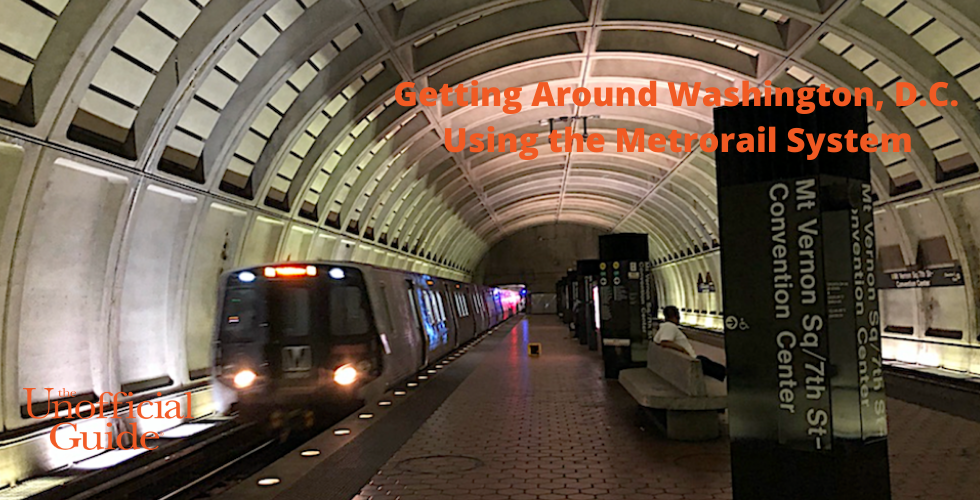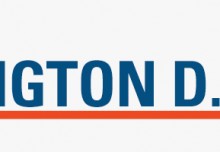Renee Sklarew, author of The Unofficial Guide to Washington, D.C., gives us an insider’s advice on how to get around Washington, D.C., using the Metrorail system.
Greetings travelers. What can I tell you about traffic in the nation’s capital? It’s challenging! So, take my expert advice and try public transportation. The Washington, D.C., Metrorail system is a convenient, eco-friendly, and cost-effective way to explore.

Sure walking is a great option, but if you’re traveling any major distance, the subway allows you to cross town without the hassle. Vehicle traffic here remains a persistent problem, and both parking garages and street parking are expensive. The Metrorail system runs underground and on dedicated tracks, allowing you to travel to destinations around the city in a timely manner; it’s truly the best way to travel.
Even when you arrive by car, the park-and-ride method allows you to park your car and ride to key locations in the city. The Metrorail system—known as “the Metro”—connects the outer suburbs to the city with 117 miles of track and 91 stations throughout the Washington area.
What safety measures are in place now for COVID? Metro has implemented safety measures in accordance with federal law to protect passengers and employees. When entering the Metrorail station or riding the Metrorail, everyone must wear a face covering over their nose and mouth, except for passengers younger than 2 years old. Metro has enhanced its cleaning and disinfecting protocols, and all frontline employees are required to wear face masks.

What are the trains like? The Metro is a relatively clean, safe, and comfortable system that saves visitors time, money, and energy. The trains are fairly quiet, with seats and aisles for standing, electronic signage posting the next stop, and heating and air-conditioning. The stations are clean, with signature arching concrete panel ceilings; in many stations the electrified tracks run along the wall with a platform in the middle. The wide-open design also explains why Metro is less susceptible to the sort of pickpocketing and petty crime often associated with subways: There are few places for thieves to hide, especially with the extensive closed-circuit TV and car-to-operator intercoms. Metro also has its own police and security force.
What are the hours? Trains operate Monday–Friday, 5 a.m.–12 a.m.; Saturday, 7 a.m.–12 a.m.; and Sunday, 8 a.m.–12 a.m. Holiday schedules and special events vary, so check for information at wmata.com.
During peak hours (weekdays 5–9:30 a.m. and 3–7 p.m.), trains run every 4–6 minutes; in off-peak hours, the wait averages 12 minutes and can be as long as 30 minutes at night and on weekends. The stations have signs indicating when the next train is expected. Check the brown poles for a list of stops on that train/line before you board to ensure you’re on the right train going the correct direction. The system undergoes track work and repairs, so prepare to adjust your plans around possible station and rail closures.
How do I find a station? Look for street signs that indicate the direction and number of blocks to the nearest Metro station. When you find the brown poles marked with a big “M,” colored stripes around the column show which lines serve that station. Many downtown stations (like Eastern Market, Waterfront, Dupont Circle, etc.) have concrete awnings over the escalators.
Because most stations, especially in D.C., are underground, passengers usually have to descend to the mezzanine to ride, buy passes, or add money. Stations have stairs, escalators, and elevators. But breakdowns do happen. If an elevator is out at a particular station, wheelchair users can ride to the next station, and shuttle service will be available.

Metro allows you to move from the District of Columbia to Northern Virginia and two counties in Maryland, with more stations under construction. It’s the second-busiest system in the country after New York City’s, transporting about 600,000 passengers every day, and it’s fully accessible for people with disabilities. Each of the six color-coded lines—Red, Blue, Green, Yellow, Silver, and Orange—run from the outlying counties through downtown D.C. The Silver line, Metrorail’s most recent addition, runs west from the District to Tysons Corner and Reston, with a station under construction at Dulles Airport.
How do you buy a ticket to ride? The easiest way is to buy a SMARTRIP card at a station for $5, which includes $3 worth of travel. Another option is to purchase a Metro SmarTrip cards in advance at smartrip.wmata.com/storefront; they are available in denominations of $10 and $30. Other online options include a 1-day pass for $15, a 3-day unlimited pass for $30, and a couple of 7-day plans for $28 (during off-peak times only).

You can pick up a Metro map at the station. Or, before you travel, you can download an official Metro Visitor’s Kit, which includes a Metro map, sites of interest near Metro stations, and hours and fare information. The Metro Pocket Guide and map is available for downloading in English and six additional languages; several others can be read in translation on the website. If you prefer to have it mailed, call 888-SMARTRIP (762-7874), but allow five business days for delivery. There are service kiosks inside every station entrance, and attendants will be happy to help you sort out your directions. Or ask a local; many will volunteer assistance if you look bewildered.

Does Metrorail have any rules? Some international visitors are accustomed to eating and drinking on their subway systems, but consumption of any sort is not allowed in Metro stations, buses, and trains. You may carry water or coffee in a mug or food in a bag, but keep it closed. No smoking is allowed. Use earbuds or headphones for listening to music and/or video devices. Also, observe the signs for seating reserved for seniors and disabled riders. If you see a parent with a child or a pregnant woman, please offer your seat. Important: Always let the passengers off the train before trying to board yourself, and report any unattended bags to station managers.
Do not shove your arm between subway car doors as they are closing. These do not respond like elevator doors and will not reopen because of the obstruction. Make sure you don’t let a purse strap or backpack get caught, either, because you’re likely to see it dragged away. Backpacks and suitcases take up a lot of room. It is not polite to rest them on the seat or block the aisles. Leave space available next to you unless there are an ample number of seats available.
Any advice for new riders? Although it is not an actual rule, when standing on the Metro escalators, position yourself on the right side. The left side is reserved for those who are walking or climbing. If you block the left side of the moving stairs, expect to hear “Stand to the Right!” For everyone’s comfort, please adhere to the custom.
The Metro is very safe and not usually crowded these days, but it is a people-mover, which means you may have to endure groups of teenagers and sports fans from time to time. Isolated incidents of violence are very rare, but as with anywhere you go, remain alert. If you feel concerned for your safety, move closer to other passengers, or get out of the train and take the next one. So, hop on the Metrorail system—it’s an iconic Washington, D.C., experience!
If you enjoyed this post, please subscribe to our YouTube channel and sign up for our newsletter here. Be sure to follow us on Twitter, Facebook, Instagram, Pinterest, and YouTube.



